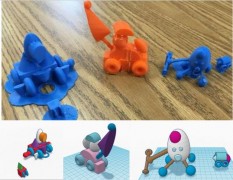This lesson is for : Grade 4:
Summary
Mission to Mars allows students the opportunity to apply their knowledge of science, technology, and engineering to design a spacecraft capable of completing specific objectives on the surface of the planet Mars. After reviewing a number of important characteristics about the planet, students analyzed previous NASA missions which were crucial in obtaining much of the scientific knowledge we currently have on the Red Planet. By combining ideas gained from these successful endeavors, as well as being aware of the many challenges and obstacles faced, students created a design of either a lander or rover whose aim was to carry out the objectives of their choice. Students were responsible for selecting a proper landing site, based on NASA images of the planet’s surface. Students viewed a series of images from 3 areas of Mars, and based on their analysis of the surface features, chose a location they felt would be an area to successfully complete their chosen objectives. After drawing a blueprint of their spacecraft, students used Tinkercad© to create a virtual model. Each component that was added needed to have an explicit purpose and be justified for being included.
TIPC Ratings
Research & Information Fluency
Rating: Ideal – Explanation: Students were engaged in research by interacting with a specially-made Google site which housed appropriate information and data on Mars and Martian exploration. Students deepened their prior knowledge of the planet by Authentic examples of planetary missions were analyzed by students in order to glean additional ideas which contributes to their final spacecraft designs. Through the use of Google slideshows and videos, students found connections with a number of previous exploration designs, NASA missions, and geographic areas of Mars. By synthesizing this information, students were able to determine appropriate objectives for their mission, the required tools and instrumentation needed to complete these goals, as well as the location on Mars which would be best to carry-out their designed plan.
Communication & Collaboration
Rating: Ideal – Explanation: Students collaborated with each other through conducting a peer-review of their rover designs. Prior to the task, students brainstormed appropriate questions they judged to be important to ask concerning the lesson. In addition to these student-created questions, students were able to use an additional instructional tool which provided them with question stems. Students were able to interview each other, inquiring about the decisions about including specific spacecraft components, provide positive feedback, and offer new ideas about possible modifications.
Critical Thinking & Problem Solving
Rating: Ideal – Explanation: Students identified, evaluated, and created higher-level questions on the given topic (Mars exploration). Students were able to use the instructional tool of a Bloom’s taxonomy flipbook for assistance. With laptops, students employed convergent thinking skills to select the most appropriate landing location for their spacecraft through assessing the pro’s and con’s of three previously selected sites on the planet. Students used divergent thinking to brainstorm many possible tools and components to include in their design, as well as which objectives they would like their rover to complete. After designing a blueprint of their model, students collaborated with each other to evaluate the designs and each student was responsible for justifying the ideas they included.
Creativity & Innovation
Rating: Ideal – Explanation: Students synthesized their research, information, and ideas into a three-dimensional model of their personal Mars’ rover. Using their knowledge gained as well as their own unique ideas, each student completed a blueprint, virtual design, and finally a three-dimensional artifact. As they were completing the design process, each student made innovative additions which elevated their original ideas. Since the selected website for 3D printing, www.tinkercad.com, has only a select group of shapes with which to build, students had to use their ingenuity in order to integrate their ideas in their designs with what shapes were available to them. Through combining and many modifications, each student ultimately found his/her own method of creating a finished product which closely matched their initial representation.





